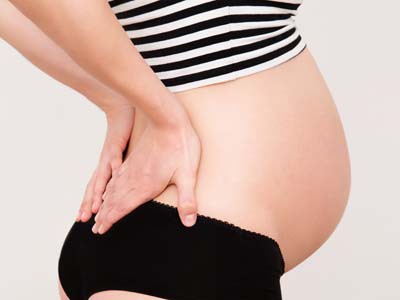Article reviewed and approved by Dr. Ibtissama Boukas, physician specializing in family medicine
It is often said that pregnancy is not a disease, but it causes certain symptoms that can be bothersome such as sciatica. A pregnant woman could therefore feel pain on the way to the sciatic nerve. The pain is usually moderate, consisting more of a sciatica only in one sciatica.
You are pregnant, you feel pain or pinching in the buttocks that extends behind the thigh, leg or foot? Do you know a pregnant woman complaining of such symptoms? This article is therefore welcome for you.
This popularized article will first make a reminder of the terms sciatica et sciatica. He will then explain the mechanisms of occurrence of a sciatica in pregnant women and then disclose how to treat and prevent it.
Reminder on sciatica and sciatica
Definition
Sciatic neuralgia refers to pain along the path of the sciatic nerve from its emergence in the lumbar region. We commonly speak of lumbosciatica. It is therefore a lower back pain with distal painful irradiation (going to the periphery of the body) in the lower limb. It is located in the L5 or S1 root nerve territory, associated with signs of root tension.
Sciatica is a syndrome whose main element is a very sharp pain sitting along the course of the sciatic nerve (or ischial) and its branches. This syndrome has many etiologies which result in nerve damage ranging from irritation (neuralgia) to injury (neuritis).
Sciatica, on the other hand, is defined as “sciatic neuralgia” or pain located in the path of the sciatic nerve. In the case of pregnancy, only 1% of lower back pain is due to true sciatica. Pregnant women are more prone to sciatica with a peak in the frequency of occurrence between the 5th and 7th month of pregnancy.
In the rest of this article, the term sciatica will therefore designate both true sciatica and sciatica. (See full article on sciatica).
Symptoms of the disease
Le sciatic nerve has two functions: sensory and motor. Impairment of sensory function leads to pain, tingling and/or loss of sensitivity. The pain may manifest as a slight pulling or burning sensation. In more severe damage to the sciatic nerve, this pain can be searing. The pain is along the path of the nerve. It can radiate into the lower back, the buttocks, the posterior surface of the thigh to the toes. The pain felt is always distal to the focal point of nerve irritation. If the focus is located in the buttock, there will be no painful sensation in the lumbar region.
Impairment of the motor function leads to a variable motor deficit, going as far as paralysis in the most serious cases. Paralysis of the sciatic nerve results in the impossibility of running, bending the leg, standing on tiptoe (damage to the S1 nerve root) or on the heels (damage to L5). During the neurological examination there is an abolition of the usual neurological reflexes, muscular atrophy and vasomotor and trophic disorders.
Vasomotor disorders are circulatory disorders due to a relaxation of the vessels (redness) or their constriction (pallor). For example, Raynaud's phenomenon is a vasomotor disorder.
Skin trophic disorders result in pigmentation, discoloration or atrophy. They can also affect the underlying tissues (aponeuroses, muscles, tendons, fatty tissues), in the form of ulcerations. In some cases, they can affect the deep organs, causing edema, pressure sores or muscle atrophy.
Moreover, in the particular case of the sciatica with cauda equina syndrome, sphincter signs (incontinence or retention) and saddle anesthesia are triggered. This is a medical emergency requiring prompt intervention.
Why does sciatica appear during pregnancy?
The hormonal, mechanical and muscular modifications due to the state of pregnancy can explain the frequent appearance of sciatica in pregnant women. The painful phenomena come from the same causes as sciatica in the general population, but are accentuated by the state of pregnancy.
Hormonal impregnation
La relaxin is a hormone produced in abundance during pregnancy. In synergy with estrogens, it modifies the homogeneous assembly of collagen fibers. This leads to an increase in the flexibility of the spine, hyperlaxity of the ligaments at the level of the sacroiliac joints, sacrococcygeal, lumbar intervertebral and symphysis.
This impregnation of the connective tissues has the role of facilitating the growth of the uterus in the pelvis, then the progression of the baby through the birth canal at birth. However, ligamentous hyperlaxity will weaken the static support capacity of the spine and weaken resistance at the pelvic level, hence the sciatic.
Mechanical modifications
The weight gain in the abdominal belt and the volume of the uterus during pregnancy will induce a forward tilt of the pelvis (anteversion). The muscles of the abdomen deviate and stretch, and will be the basis of a loss of tone in the abdominal belt.
All these mechanical modifications will accentuate the lumbar lordosis (hyperlordose) and exert more stress on the spine and pelvis, then lead to sciatica. These sciatica appear all the more when there are underlying anomalies that exist before the onset of pregnancy.
Factors favoring sciatica
The risk factors for sciatica during pregnancy are:
- Multiparity (woman who has already had several deliveries): in this condition, the decline in muscle tone in the abdominal muscles and joint laxity are greater than in the nulliparous (woman in her first pregnancy).
- History of sciatica or sciatica
- The young age
- obesity
- Intense sports activities before pregnancy
- The exercise of a profession including prolonged standing
- Physical inactivity
- Carrying heavy loads
- Excessive car driving.
The consequences of sciatica on pregnancy
Sciatica causes intense and chronic pain. Its intensity increases with walking, during prolonged standing or sitting, and is maximum at the end of the day. This will impact the social life of the pregnant woman and complicate her daily and active activities. Sleep can also be impaired when pain peaks late in the day.
In addition, the newborn is influenced by sciatica. A sciatica and / or hyperlordose can have consequences on childbirth, and therefore on the skull of the newborn. If epidural analgesia is chosen during labour, the sciatica can be inconvenient. Indeed, inflammation of the nerve root locally lowers the effectiveness of local anesthetics. Epidural analgesia will therefore be less effective.
Treatment and prevention
In the case of very disabling sciatica and/or associated with a loss of strength or sensitivity, the woman must be taken care of by an appropriate specialist (neurologist, specialist in physical medicine, etc.).
For less severe sciatica, we recommend :
- Taking complexes of B vitamins which prevent the appearance of certain neuritis.
- Tier 1 painkillers such as paracetamol.
- La physiotherapy ou physiotherapy : the physiotherapist will assess the function of the stabilizing muscles of the back and the pelvis in order to provide a tailor-made training program.
- Osteopathy
- Acupuncture
- homeopathy
- Balneotherapy (treatments administered through baths).
- The application of a hot water bottle on the back or on the buttocks, a half-warm half-lukewarm bath to help reduce muscle tension. For best results, the application of heat should precede a massage or stretching exercise of the back and buttocks.
- Do not use heating creams during pregnancy as they may contain chemicals that could possibly harm the baby.
- Wearing a narrow elastic belt (pelvic band) to stabilize the pelvis, reducing discomfort associated with movement.
Some practical tips
1- Improve your posture while standing
- Always try to keep the chest parallel to the pubis
- Distribute body weight equally on both legs
- Avoid wearing high-heeled shoes
- Avoid standing too long without moving.
2- Improve your posture while sitting
- Sit well back in your chair
- Evenly distribute the weight of the body on both buttocks
- Provide support for the lower back (cushion, rolled up towel, etc.).
3- Improve your posture while lying down
- Avoid sleeping on your stomach, especially at the end of pregnancy
- Sleep on your back with a pillow under your knees
- Sleep on your side with a pillow between knees
4- Improve your posture in motion
- To get out of bed: help yourself with your hands by squeezing the stabilizing muscles (tuck in your navel slightly by squeezing your lower abdomen).
- To get up from a chair or couch: move forward, lean forward and use your legs to force. Keep your back straight and tighten your stabilizer muscles.
5- Massage and do exercises
This will involve massaging and doing stretching exercises on the muscles of the lower back and buttocks which are often tense during pregnancy. Here is an example of a leg stretching exercise to prevent the onset of sciatica (to be repeated morning and evening, alternate the legs 10 times in a row, maintain the stretch for 6 seconds).
- Lie on your back, knees bent, feet on the floor
- Pass one leg over the other then place the foot against the outer side of the thigh
- Grab the knee of the lifted leg with the opposite hand
- Pull with your hand on the knee towards your shoulder opposite the knee on the exhale for 6 seconds
- Do the same with the other leg
- If your rounded pregnancy belly makes it difficult for you to stretch, you can
ask someone else to help you.
Conclusion
Pregnancy is a condition that can lead to pain in sciatica in the woman. This pain is usually moderate and more like a sciatica. It is due to hormonal changes, mechanical stresses and muscle changes caused by pregnancy.
Unfortunately the sciatica influences the daily and social life of the pregnant woman as well as the birth process, sometimes threatening the baby. The woman must then work to improve her postures when sitting, standing, lying down and moving in order to prevent the occurrence of this annoying syndrome. The help of specialists such as the physiotherapist (physiotherapist), the neurologist, the osteopath, could also be of great necessity.
References
- https://oppq.qc.ca/blogue/douleurs-au-nerf-sciatique-femme-enceinte/
- DURIEUX J. LEVERNIEUX J. Lower back pain and sciatica in pregnant women. In: Rheumatology on the borders of obstetrics. SEZE S, GURIN C. France, Paris: French Scientific Expansion, 1981, 335-340.
- BROCHET E. Lumbosciatalgia and pregnancy…in two evils. 67p. Midwifery student thesis: Metz School of Midwifery, class of 2002-2006
- CADERAS by KERLEAU J., SERRE H., VIALA JL. Radiculalgia and lumbago during pregnancy. Bull Fel Soc Gynecology Obstetrics, 1963; 15:25
- MANTLE MJ. GREENWOOD RM. CURREY HL. Backache in pregnancy. Rhumatol Rehabil. 1977; 16: 95-101
- RICARD Francois. Osteopathic treatment of lumbago and lumbosciatic pain by herniated disc. Issy-les-Moulineaux, France: elsevier Masson SAS, 2008, 683p. ISBN: 978-2-84299-839-4
- Under the direction of B. WELCHSLER, J.JANSE-MAREC, JP PECHERE. Maternal pathologies and pregnancy. Paris, France: Medsi/MacGraw Hill, 1988, 697p. ISBN: 2-86439-157-0.
- WEST Zita. Natural pregnancy. Hachette book (French language edition), 2002, 160p. Hachette Practical Collection. ISBN 2-012-36657-0 Original title: Natural Pregnancy. London, England: Dorling Kinderley Limited, 2001.
- LALAUZE-POL R, interview by RICHARD-GUERROUDJ N. Osteopathy is essential in maternity. Midwifery n°135
- AUBERT F. Anesthesia during childbirth. Midwife student course in Metz, 29.10.2012.
If you liked the article, please share it on your social networks (Facebook and others, by clicking on the link below). This will allow your relatives and friends suffering from the same condition to benefit from advice and support.


